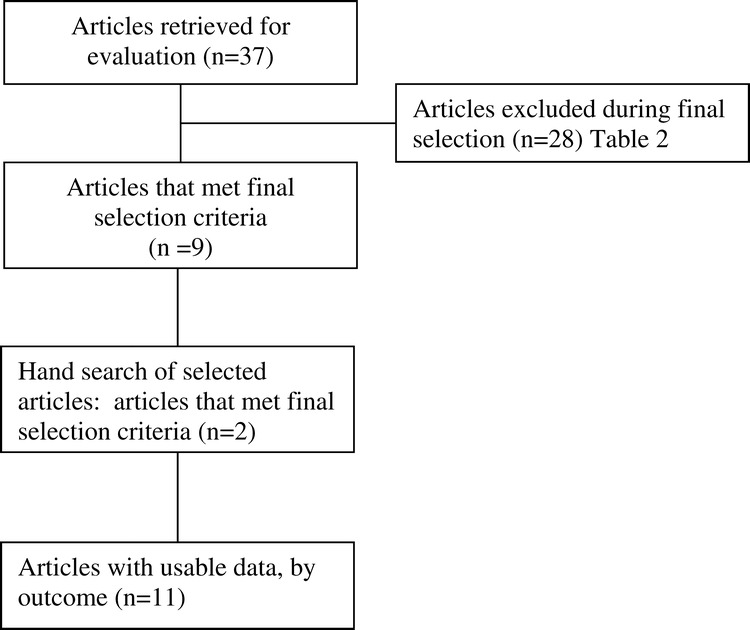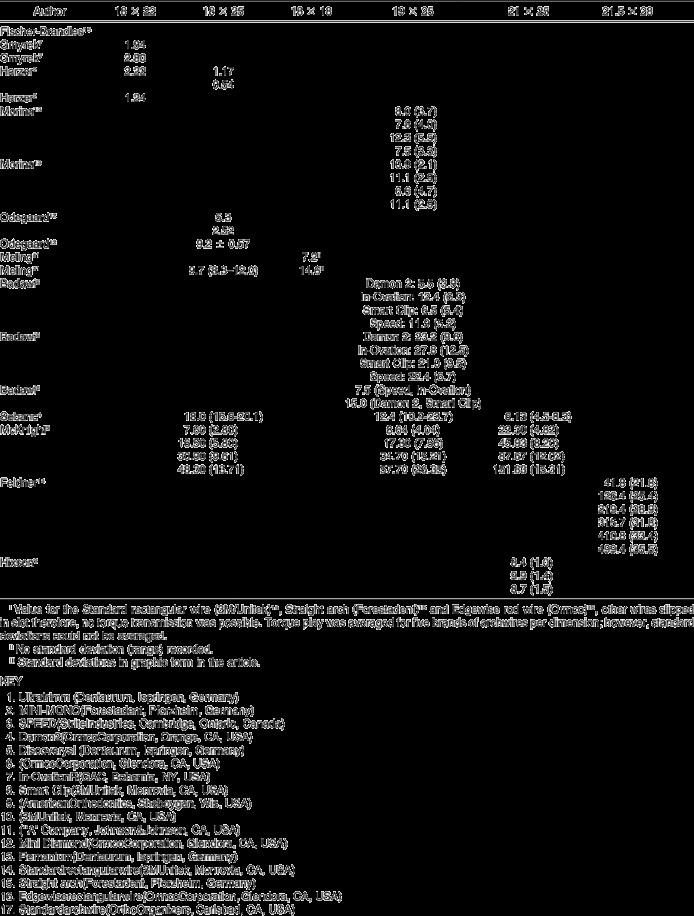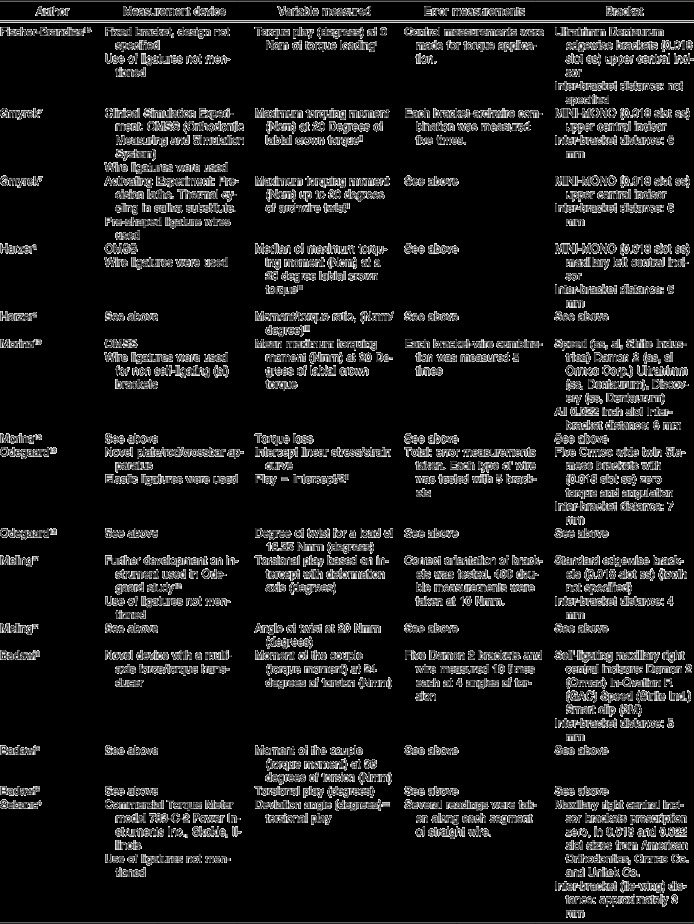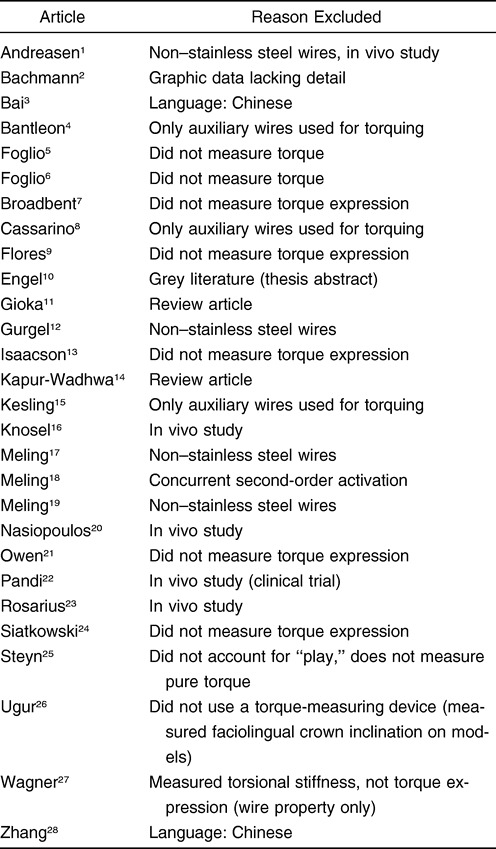Abstract
Objective:
To evaluate the quantitative effects on torque expression of varying the slot size of stainless steel orthodontic brackets and the dimension of stainless steel wire, and to analyze the limitations of the experimental methods used.
Materials and Methods:
In vitro studies measuring torque expression in conventional and self-ligating stainless steel brackets with a torque-measuring device, with the use of straight stainless steel orthodontic wire without second-order mechanics and without loops, coils, or auxiliary wires, were sought through a systematic review process.
Results:
Eleven articles were selected. Direct comparison of different studies was limited by differences in the measuring devices used and in the parameters measured. On the basis of the selected studies, in a 0.018 inch stainless steel bracket slot, the engagement angle ranges from 31 degrees with a 0.016 × 0.016 inch stainless steel archwire to 4.6 degrees with a 0.018 × 0.025 inch stainless steel archwire. In a 0.022 inch stainless steel bracket slot, the engagement angle ranges from 18 degrees with a 0.018 × 0.025 inch stainless steel archwire to 6 degrees with a 0.021 × 0.025 inch stainless steel archwire. Active stainless steel self-ligating brackets demonstrate an engagement angle of approximately 7.5 degrees, whereas passive stainless steel self-ligating brackets show an engagement angle of approximately 14 degrees with 0.019 × 0.025 inch stainless steel wire in a 0.022 inch slot.
Conclusions:
The engagement angle depends on archwire dimension and edge shape, as well as on bracket slot dimension, and is variable and larger than published theoretical values. Clinically effective torque can be achieved in a 0.022 inch bracket slot with archwire torsion of 15 to 31 degrees for active self-ligating brackets and of 23 to 35 degrees for passive self-ligating brackets with a 0.019 × 0.025 inch stainless steel wire.
Keywords: Systematic review, Self-ligation, Torque
INTRODUCTION
Torque can be defined from a mechanical or from a clinical point of view. Mechanically, it refers to the twisting of a structure about its longitudinal axis, resulting in an angle of twist. Torque is a shear-based moment that causes rotation. Clinically, in orthodontics, it represents the buccopalatal crown/root inclination of a tooth, and it is an orthodontic adaptation used to describe rotation around an x-axis. When applied in an orthodontic archwire/bracket interaction, it describes the activation generated by twisting an archwire in a bracket slot.1 Orthodontists define torque around the dental arch such that the x-axis follows the curve of the arch. Torque, in this sense, would be rotation perpendicular to the long axis of the tooth. This could be generated by a rotation through a moment or couple of forces. The terms “moment,” “torsional moment,” “couple,” “biomechanical torque,” and “third-order torque” appear to be used interchangeably in the orthodontic literature to indicate the same loading condition, although an understanding of the biomechanical implications of them will not necessarily result in pure torque.
Clinically, torque control is often required in the maxillary incisors for an ideal interincisal angle, adequate incisor contact, and sagittal adjustment of the dentition in order to achieve an ideal occlusion.2 A large variation between prescriptions exists with respect to incisor torque values. Maxillary central incisor torque ranges from 12 degrees in the Roth prescription to 22 degrees in the Bioprogressive prescription.3
Depending on magnitude of torsion, the stiffness or resilience of the wire cross section, wire size, edge bevel and manufacturer tolerance, bracket slot size and manufacturer tolerance, engagement angle of the wire in the bracket slot, experimental measurement technique, bracket placement as related to tooth morphology,4,5 and inclination of the tooth, the archwire moves the root of a tooth through the alveolar bone via localized pressure and tension generated by torsion in the archwire.2 Most orthodontic treatment is carried out with less than full-dimension archwires, leading to lack of cohesive contact between the bracket and the wire; this is known as torsional play or the engagement angle.6
The current literature on torque expression in orthodontic brackets consists of theoretical models and discussions; in vitro studies employing various measurement devices, brackets, and wire dimensions; and in vivo studies indirectly measuring torque expression via tooth inclination. It is difficult to predict the amount of torque expression that a clinician can expect from a given bracket and archwire combination. This systematic review is intended to evaluate the quantitative effects of varying the slot size of stainless steel orthodontic brackets and the dimension of stainless steel wire on torque expression. It is our intention to help the clinician to better understand the variables involved in generating torque moments when selecting stainless steel archwires for torque expression.
MATERIALS AND METHODS
A computerized database search was conducted using Medline, Embase, EBMR (Evidence-Based Medicine Reviews), EBM All Reviews, PubMed, Scopus, and Web of Science to search the literature up until June 27, 2008.
Terms and their respective truncations used in the literature search (Table 1) were specific to each database. Searches were conducted with the help of a senior librarian who specializes in the Health Sciences. The selection process was carried out together by 2 researchers. The inclusion criterion, “Measurement of torque expression in orthodontic brackets,” was chosen to initially select potential articles from the published abstract results of the database search.
Table 1. .
Database Search and Results

Once potentially adequate abstracts were selected, full articles were retrieved in a second selection process. The following additional (final) selection criterion was chosen to select articles for inclusion in this systematic review: “In vitro studies measuring torque expression in new stainless steel brackets with a torque-measuring device with straight stainless steel orthodontic wire without second-order mechanics and without loops, coils or auxiliary wires.”
Studies that measured friction, bracket deformation/ failure, wire torsion, bracket position, or tooth morphology without evaluating torque were excluded. Theoretical studies of torque expression without practical application also were excluded.
The QUOROM statement checklist was followed; however, several points did not apply to this systematic review in that it was a review of in vitro studies rather than randomized control trials. Validity was assessed by critically examining the torque-measuring devices and methods employed in each study.
RESULTS
Thirty-seven abstracts met the initial inclusion criteria. Once the full articles were retrieved, only 9 met the final inclusion criteria. Reasons for exclusion at the final selection stage are stated in the Appendix. A hand-search of the reference lists in the 9 articles that met the final inclusion criteria identified 2 additional articles. A total of 11 articles met the final inclusion criteria (Figure 1). Two studies2,7 were intended to evaluate torque expression in plastic brackets but were included because they used metal brackets as a control. The study by Hixson8 was intended to evaluate changes in bracket slot tolerance following recycling of metal brackets. Because baseline values using new metal brackets were measured, this part of the data was included in this systematic review. Two articles in Chinese9,10 were excluded because of language as no translator for the dialect was available.
Figure 1.

Flow diagram of the literature search
The methods and results of each selected article have been summarized in Table 2. Several variables were measured to represent torque expression; however, results on measurement of the engagement angle will be emphasized.
Table 2. .
Methodology of selected articles (see Key at bottom of Table 3)

Table 2. .
Continued

Table 3. .
Torque play results of selected articles

The angle of twist of the archwire in degrees at 20 Nmm was measured by Meling11 and Odegaard.12 The maximum torquing moment in Ncm at 20 degrees of archwire torsion was measured by Gmyrek7 and Harzer.2 Morina13 measured the maximum torquing moment in Nmm at 20 degrees of archwire torsion, as well as torque loss. Results indicate that Morina13 noted mean moments of 8.0 Nmm for the Speed bracket (Strite Industries, Cambridge, Ontario, Canada) and 7.8 Nmm for the Damon 2 bracket (Ormco Corporation, Orange, CA, USA) with a 0.019 × 0.025 inch stainless steel wire in a 0.022 inch slot with the orthodontic measuring and simulation system (OMSS). Testing the same wire and bracket slot combination, Badawi6 recorded 5.5 to 12.4 Nmm, depending on bracket brand, with Speed (Strite Industries, Cambridge, Ontario, Canada) measuring 11.9 Nmm and Damon 2 (Ormco Corp, Orange, CA, USA) measuring 5.5 Nmm. Gmyrek's experiments with the precision lathe produced results that resemble those of Badawi.6 At 30 degrees of torsion, Gmyrek reported a moment of 2.09 Ncm (20.9 Nmm). Badawi6 measured the moment of the couple at 24 and 36 degrees with values of 5.5 to 12.4 Nmm at 24 degrees and 21.0 to 27.8 at 36 degrees. In addition, Badawi6 measured the engagement angle from the archwire twist to the moment graph as the point at which a positive torque moment was detected after the initial lag period. The torque in g-cm was measured at 5 degree intervals by McKnight.5 The torque moment was measured in g-cm at 5 degree intervals by Feldner.14 Fischer-Brandies15 measured the engagement angle in degrees at 0, 1, and 3 Ncm of torque loading. The values chosen to be evaluated in this systematic review were those measured at 0 Ncm to represent the contact angle. The engagement angle was measured in degrees. In a 0.018 inch bracket slot, it ranged from 31 degrees with a 0.016 × 0.016 inch archwire to 4.6 degrees with an 0.018 × 0.025 inch archwire. In a 0.022 inch bracket slot, the engagement angle ranged from 18 degrees with an 0.018 × 0.025 inch archwire to 6 degrees with a 0.021 × 0.025 inch archwire.4,6,8,11,12,15
DISCUSSION
The current systematic review identified 11 in vitro studies in which conventional and self-ligating metal brackets that quantified torque expression were used under different working conditions and different torque parameters were measured. These studies were dissimilar in the methods and parameters tested. So that a meaningful conclusion would be drawn, studies measuring the same parameter were compared.
Engagement Angle
The engagement angle was selected for comparison between studies because it was the parameter that was tested by most of the studies. The engagement angle was measured directly in the study by Fischer-Brandies.15 On the other hand, the engagement angle can be measured indirectly from the twist/ moment curve through several different methods. One can measure the archwire torsion when a positive torque moment is first observed, as did Badawi.6 This is probably the best method in that it uses real data points rather than extrapolated points to identify the angle at which a positive torque moment is produced. One may estimate the engagement angle by extrapolating the linear portion of the twist/moment curve back to the x-axis.11,12 Alternatively, the engagement angle can be measured by converging the data from both clockwise and counterclockwise torsion and finding the midpoint between the two x-intercepts.4,8 Extrapolating from the linear portion of the twist/moment curve assumes a relationship that does not exist because we know that there is a “lag” prior to the critical contact angle, when the archwire is not engaged in the bracket slot. This method does not account for the twist from the time the wire engages the bracket to the point at which the relationship between the angle of twist and the moment is linear. Rather, it is assumed that the relationship is linear immediately.
Fisher-Brandies15 applied 3 torque values (0, 1, and 3 Ncm), Results at 0 Ncm were utilized in this systematic review as this loading condition represents the critical contact angle. A value of 1 Ncm was deemed to be clinically relevant, whereas 3 Ncm was deemed to be an excessive amount of torque from a clinical point of view; however, the study was designed to test the weaknesses of the slot wire system. Because the value at which torque becomes clinically relevant is unknown, this method may be arbitrary. Gmyrek7 has suggested that the range of clinically effective torque is between 5 and 20 Nmm.
Experimental Measurement Devices Used to Quantify Torque Expression
A total of 8 devices were used to measure torque expression in its various forms in the 11 studies. Several studies measured torque expression using different styles of lathes.5,7,8,14 Inaccuracy may occur if the pulley does not fit tightly around the lathe, thus producing an axial force. To prevent this axial force development and consequent energy loss, a pulley that exerts a force couple could be used. In addition, the wire may distort or twist within the lathe, leading to frictional torque loss. Gmyrek,7 Harzer,2 and Morina13 used the OMSS16 to measure the maximum torquing moment. This device has 6 degrees of load measuring freedom. It ensures that only torque in a single plane is present (buccal-lingual) by automatically adjusting itself through a load sensor feedback system. Torque values were smaller for the OMSS experiments conducted by Gmyrek7 and Harzer2 than for Gmyrek's activating experiment.2,7 Torque loss was attributed to increased play caused by adjacent bracketed teeth embedded in wax, as opposed to other in vitro studies, such as the activating experiment by Gmyrek,7 in which a device firmly clamps a test bracket or a series of brackets on both sides. Badawi et al6 developed a novel apparatus while also using a 6 degree of freedom multiaxis force/torque transducer. Torque was measured as the wire was twisted; all other forces and moments were kept to zero by device alignment. Vertical and horizontal alignment was maintained between the wire and the bracket during this process. The apparatus consisted of a wire support substructure and alignment dies on either side of a bracket on a dual turntable system secured over the sensor.
Three articles measuring the engagement angle increased archwire twist incrementally6,11,12; however, another 24,8 took only 4 data points for each clockwise and counterclockwise archwire twist and assumed a linear torque/twist relationship, extrapolating back to the x-axis to calculate the engagement angle. Collection of additional data points would have provided a more accurate curve.
Other Factors Affecting Measured Torque
According to several authors, the mean engagement angle measured was greater than the theoretical engagement angle because the wires were undersized and had rounded edges.4,11,15 Another factor that can increase the engagement angle is bracket slot dimension. When torque is applied, notching of the slot walls and additional widening of the slot by up to 0.016 mm can occur.15 Bracket deformation does not increase the engagement angle but does affect the amount of torque delivered by the archwire twist. Elastic ligatures were found to have a restraining effect on the amount of torque expression, but this effect was of limited duration.11,12
Torque Expression in Self-Ligating Metal Brackets
Two recent studies have tested torque expression in metal self-ligating brackets.6,13 A comparison may be made between the results of these studies, both of which tested 0.019 × 0.025 inch wire in the 0.022 inch bracket slot; however, Badawi6 measured the moment of the couple at 24 degrees of labial crown torque, whereas Morina13 measured the moment of the couple at 20 degrees of labial crown torque. Morina13 noted no significant difference between the moments generated by the Speed and Damon 2 brackets, whereas Badawi6 found a significant difference between the 2 brackets. The 2 active, self-ligating brackets in Badawi's study, In-Ovation R (GAC, Bohemia, NY, USA) and Speed, showed similar results to the OMSS studies by Gmyrek7 and Harzer,2 whereas the passive self-ligating brackets (Damon 2 and Smart Clip (3M Unitek, Monrovia, CA, USA)) demonstrated lower torsional moments. We would expect to see lower torque values in the OMSS experiments because of torque loss caused by adjacent brackets; however, in the study by Badawi,6 Damon 2 exhibited a lower moment than in the study by Morina.13 However, if the standard deviations are considered, this difference is minimized. The difference between active and passive self-ligating bracket designs was evident. If one considers the range of clinically effective torque to be between 5 and 20 Nmm,7 this range can be attained at 15 to 31 degrees of torsion with the active self-ligating brackets, and at 22.5 to 34.5 degrees with the passive self-ligating brackets, with a 0.019 × 0.025 inch stainless steel archwire in a 0.022 inch slot.6
When the results of torque tests on multiple wires from different companies were averaged, no statistically significant difference was noted in the engagement angle between the 0.018 inch slot and the 0.022 inch slot for the wire sizes tested (0.018 inch slot: 0.016 × 0.016 inch, 0.016 × 0.022 inch, 0.017 × 0.025 inch; 0.022 inch slot: 0.018 × 0.025 inch, 0.019 × 0.025 inch, 0.021 × 0.025 inch).4 Six studies4,6,8,11,12,15 measured the engagement angle and therefore can be compared, although differences in wires tested and bracket slot dimensions tested limit the comparison.
Clinical Relevance of the Results
Clinical research is needed to determine the average amount of tooth movement in degrees produced by the range of torsion resulting in 5 to 20 Nmm of torque expression. With this information, the clinician will be able to calculate the amount of torque moment required in a particular clinical situation. Standardized bracket slot, archwire dimensions and edge bevel are required to accurately predict torque expression.
Overall, these studies indicate that the engagement angle is clinically significant and variable and is affected by archwire dimension and edge shape, as well as by bracket slot dimension. This variable torsional play was found to be greater than the theoretical nominal values published previously by Dellinger17 and Creekmore.18 In a 0.018 inch bracket slot, the published nominal values are 9.6217 according to Dellinger17 and 16.718 according to Creekmore18 for a 0.016 × 0.016 inch stainless steel archwire, and 1.5017 according to Dellinger17 and 2.018 according to Creekmore18 for an 0.018 × 0.025 inch archwire, in contrast to the values found in this systematic review, of 31 degrees and 4.6 degrees, respectively. In a 0.022 inch bracket slot, the published nominal values for play are 11.0217 according to Dellinger17 and 14.818 according to Creekmore18 for a 0.018 × 0.025 inch stainless steel archwire and 1.7417 according to Dellinger17 and 3.918 according to Creekmore18 for a 0.021 × 0.025 inch archwire; this systematic review found these values to be 18 degrees and 6 degrees, respectively. In light of these findings, clinicians should consider the magnitude of the engagement angle when selecting bracket prescription and/or torque to be added in the finishing stages.
This systematic review did not attempt to compare self-ligating brackets vs conventional brackets. Nine of the 11 selected articles measured torque expression in conventional brackets, whereas only 2 measured torque expression in self-ligating brackets, and 1 study13 measured both.
From a clinical perspective, initial proclination or retroclination of the anterior teeth and/or buccal or lingual crown inclination of the posterior teeth will affect the engagement angle and the final position of the teeth. This produces variability in the clinical response to a given archwire and bracket combination.
CONCLUSIONS
The measured engagement angle is greater than theoretical values and is highly variable.
For conventional stainless steel orthodontic brackets with a 0.018 inch stainless steel bracket slot, the engagement angle ranges from 31 degrees with a 0.016 × 0.016 inch stainless steel archwire to 4.6 degrees with a 0.018 × 0.025 inch stainless steel archwire. In a 0.022 inch stainless steel bracket slot, the engagement angle ranges from 18 degrees with a 0.018 × 0.025 inch stainless steel archwire to 6 degrees with a 0.021 × 0.025 inch stainless steel archwire.
Active stainless steel self-ligating brackets demonstrate an engagement angle of approximately 7.5 degrees, whereas passive stainless steel self-ligating brackets show an engagement angle of approximately 14 degrees with 0.019 × 0.025 inch stainless steel wire in a 0.022 inch stainless steel bracket slot. Clinically effective torque can be achieved with archwire torsion of 15 to 31 degrees for active self-ligating brackets and 22.5 to 34.5 degrees for passive self-ligating brackets with 0.019 × 0.025 inch stainless steel wire in a 0.022 inch stainless steel bracket slot.6 This difference is due in part to a larger engagement angle in the passive self-ligating brackets compared with the active self-ligating brackets.
Acknowledgments
Dr Flores-Mir is supported by an AAOF award (Eugene E. West Memorial Fellowship Award). Our thanks to Joanne Lafrance for her assistance in editing and proofreading this manuscript.
APPENDIX
Articles Not Selected From the Initial Abstract Selec tion List With Reasons for Exclusion

REFERENCES
- 1.Wagner J. A, Nikolai R. J. Stiffness of incisor segments of edgewise arches in torsion and bending. Angle Orthod. 1985;55:37–50. doi: 10.1043/0003-3219(1985)055<0037:SOISOE>2.0.CO;2. [DOI] [PubMed] [Google Scholar]
- 2.Harzer W, Bourauel C, Gmyrek H. Torque capacity of metal and polycarbonate brackets with and without a metal slot. Eur J Orthod. 2004;26:435–441. doi: 10.1093/ejo/26.4.435. [DOI] [PubMed] [Google Scholar]
- 3.Pandis N, Strigou S, Eliades T. Maxillary incisor torque with conventional and self-ligating brackets: a prospective clinical trial. Orthod Craniofac Res. 2006;9:193–198. doi: 10.1111/j.1601-6343.2006.00375.x. [DOI] [PubMed] [Google Scholar]
- 4.Sebanc J, Brantley W. A, Pincsak J. J, Conover J. P. Variability of effective root torque as a function of edge bevel on orthodontic arch wires. Am J Orthod. 1984;86:43–51. doi: 10.1016/0002-9416(84)90275-6. [DOI] [PubMed] [Google Scholar]
- 5.McKnight M. M, Jones S. P, Davies E. H. A study to compare the effects of simulated torquing forces on pre-adjusted orthodontic brackets. Br J Orthod. 1994;21:359–365. doi: 10.1179/bjo.21.4.359. [DOI] [PubMed] [Google Scholar]
- 6.Badawi H. M, Toogood R. W, Carey J. P, Heo G, Major P. W. Torque expression of self-ligating brackets. Am J Orthod Dentofacial Orthop. 2008;133:721–728. doi: 10.1016/j.ajodo.2006.01.051. [DOI] [PubMed] [Google Scholar]
- 7.Gmyrek H, Bourauel C, Richter G, Harzer W. Torque capacity of metal and plastic brackets with reference to materials, application, technology and biomechanics. J Orofac Orthop. 2002;63:113–128. doi: 10.1007/s00056-002-0065-x. [DOI] [PubMed] [Google Scholar]
- 8.Hixson M. E, Brantley W. A, Pincsak J. J, Conover J. P. Changes in bracket slot tolerance following recycling of direct-bond metallic orthodontic appliances. Am J Orthod. 1982;81:447–454. doi: 10.1016/0002-9416(82)90422-5. [DOI] [PubMed] [Google Scholar]
- 9.Zhang J, Bai D, Gu M, Kang N. [Influence of loops on the torsion stiffness of rectangular wire] Sichuan Da Xue Xue Bao Yi Xue Ban. 2004;35:361–363. [PubMed] [Google Scholar]
- 10.Bai D, Gu M, Zhang J. [Incisor torque control with fixed appliance] Zhonghua Kou Qiang Yi Xue Za Zhi. 2004;39:104–107. [PubMed] [Google Scholar]
- 11.Meling T. R, Odegaard J, Meling E. O. On mechanical properties of square and rectangular stainless steel wires tested in torsion. Am J Orthod Dentofacial Orthop. 1997;111:310–320. doi: 10.1016/s0889-5406(97)70190-2. [DOI] [PubMed] [Google Scholar]
- 12.Odegaard J, Meling T, Meling E. An evaluation of the torsional moments developed in orthodontic applications: an in vitro study. Am J Orthod Dentofacial Orthop. 1994;105:392–400. doi: 10.1016/S0889-5406(94)70134-2. [DOI] [PubMed] [Google Scholar]
- 13.Morina E, Eliades T, Pandis N, Jager A, Bourauel C. Torque expression of self-ligating brackets compared with conventional metallic, ceramic, and plastic brackets. Eur J Orthod. 2008;30:233–238. doi: 10.1093/ejo/cjn005. [DOI] [PubMed] [Google Scholar]
- 14.Feldner J. C, Sarkar N. K, Sheridan J. J, Lancaster D. M. In vitro torque-deformation characteristics of orthodontic polycarbonate brackets. Am J Orthod Dentofacial Orthop. 1994;106:265–272. doi: 10.1016/S0889-5406(94)70046-X. [DOI] [PubMed] [Google Scholar]
- 15.Fischer-Brandies H, Orthuber W, Es-Souni M, Meyer S. Torque transmission between square wire and bracket as a function of measurement, form and hardness parameters. J Orofac Orthop. 2000;61:258–265. doi: 10.1007/s000560050011. [DOI] [PubMed] [Google Scholar]
- 16.Bourauel C, Drescher D, Thier M. An experimental apparatus for the simulation of three-dimensional movements in orthodontics. J Biomed Eng. 1992;14:371–378. doi: 10.1016/0141-5425(92)90081-u. [DOI] [PubMed] [Google Scholar]
- 17.Dellinger E. L. A scientific assessment of the straight-wire appliance. Am J Orthod. 1978;73:290–299. doi: 10.1016/0002-9416(78)90135-5. [DOI] [PubMed] [Google Scholar]
- 18.Creekmore T. D, Thomas D. Creekmore on torque. J Clin Orthod. 1979;13:305–310. [PubMed] [Google Scholar]


